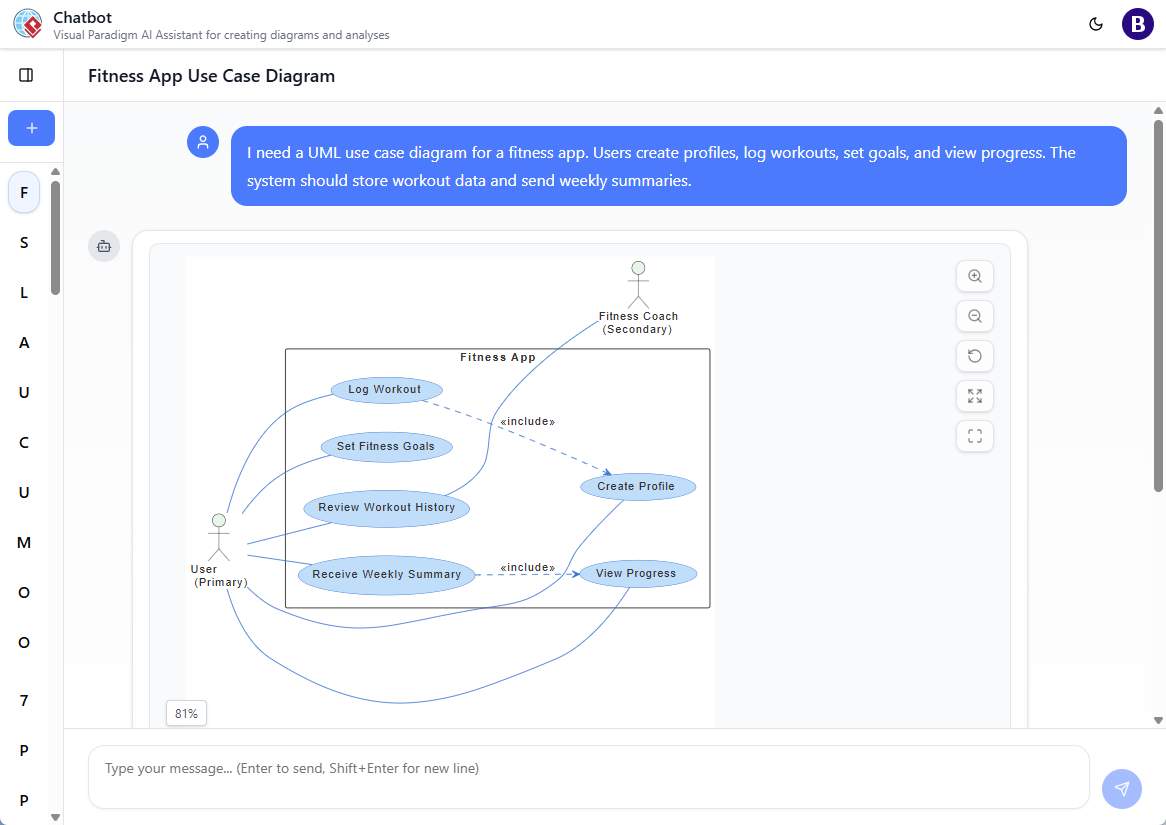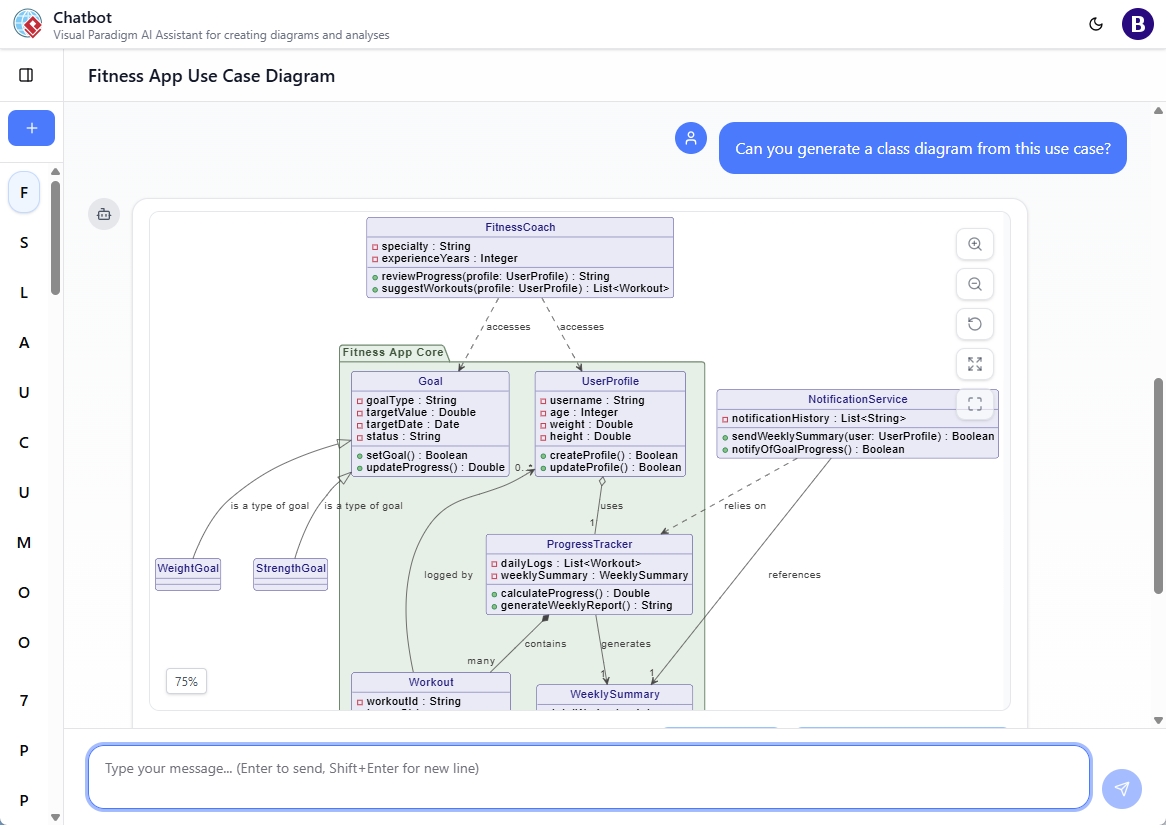How Developers Can Accelerate Software Design with AI-Generated UML Diagrams
Imagine you’re building a new e-commerce app. You know the system needs to handle user profiles, product listings, orders, and payments. But writing down all the interactions—how users flow through the system, how components talk to each other—is time-consuming and easy to miss.
What if you could describe the system in plain English, and in seconds, get a clean, correct UML diagram to work with?
That’s exactly what modern developers are doing with AI-powered modeling tools. One of the most powerful applications is generating UML diagrams using natural language input—something that used to take days of manual work now happens in minutes.
What Is an AI Chatbot for Diagramming?
An AI chatbot for diagramming helps developers turn written descriptions into visual models. Instead of drawing shapes by hand or manually mapping classes and interactions, you describe the system, and the AI creates the UML diagram—like a digital assistant that understands software design.
This isn’t magic. It’s training in modeling standards, combined with real-world experience in software architecture. The AI knows how to interpret phrases like “a user places an order” and convert them into accurate class and sequence diagrams.
It’s not just about drawing. It’s about making sure the output follows best practices in software design.
When to Use AI-Generated UML Diagrams
Here are real-world moments when developers benefit from AI-generated UML diagrams:
- During requirement discussions with product managers or stakeholders
You explain the user journey: “A customer browses products, selects items, and checks out.” The AI creates a use case diagram that shows the flow clearly. - After a sprint planning meeting
You write a quick summary of new features: “We need a payment processing module that validates card data.” The AI generates a class diagram with the relevant components. - When debugging system behavior
A developer notices a gap in how services communicate. They ask: “How does the order service talk to the inventory system?” The AI returns a sequence diagram showing the interaction.
These are not edge cases. They’re common moments in software development where time is tight and clarity is critical.
Why This Matters to Developers
Traditional UML diagramming tools require you to know the syntax, pick the right shapes, and manually link elements. That creates friction—especially for teams new to modeling or under tight deadlines.
With an AI diagram chatbot, you avoid that friction. You just describe what you want, and the system responds with accurate, standardized diagrams.
For example:
“Create a class diagram for a banking app with users, accounts, and transactions.”
The AI returns a structured diagram with proper relationships—inheritance, associations, and dependencies—without you having to define every rule or shape.
This is particularly useful in:
- Agile environments where changes happen fast
- Onboarding new team members who need to understand system structure
- Early-stage brainstorming to validate architecture ideas
And the best part? You can refine it further. If you want to add a new class or adjust a relationship, you can simply say: “Add a fraud detection service to the system.” The AI updates the diagram with the correct placement and interaction.
How to Use It in a Real Project
Let’s say you’re working on a fitness app. Your team has identified a core feature: users log workouts, and the system tracks progress.
You start by describing the system:
“I need a UML use case diagram for a fitness app. Users create profiles, log workouts, set goals, and view progress. The system should store workout data and send weekly summaries.”
You paste that into the AI chatbot. In less than a minute, it generates a clean use case diagram showing:
- User roles (User, Fitness Coach)
- Associations (User -> Log Workout / Set Fitness Goals / Review Workout History / Receive Weekly Summary)

Later, when you need to expand on the internal structure, you ask:
“Can you generate a class diagram from this use case?”
The AI delivers a class diagram with classes like UserProfile, Workout, ProgressTracker, and Goal, showing how they relate to each other.

Full chat session can be found here: https://ai-toolbox.visual-paradigm.com/app/chatbot/?share=9c3460ae-7d73-4b37-b62e-abc80e94d687
If you want to change something—say, add a “notification” feature—you can just say:
“Add a notification service that sends alerts when a goal is met.”
The AI updates the diagram and adds the new class and interaction.
You’re not coding the diagram. You’re guiding the AI through a natural conversation. That’s the power of AI-powered software design.
Beyond UML: What Else Can the AI Do?
The AI diagram chatbot doesn’t stop at UML. It supports enterprise standards like ArchiMate and C4, and business frameworks like SWOT or Eisenhower Matrix. Developers can use it to:
- Understand how to realize a deployment configuration
- Explain how software components fit together in a system context
- Get explanations of modeling decisions when they’re unsure
For developers, this means they can now ask questions like:
- “How to realize this deployment configuration?”
- “What does a container diagram show in C4?”
- “What are the key differences between a sequence and activity diagram?”
And get clear, context-aware answers.
Why Visual Paradigm Stands Out in AI Diagramming
Not all AI tools for diagramming deliver accurate, standard-compliant outputs. Many produce diagrams that look good but miss key modeling rules or fail to represent interactions correctly.
Visual Paradigm’s AI diagram chatbot is trained on real-world modeling standards. It understands how UML classes relate, how sequence diagrams show timing, and how use cases map to user behavior.
It supports natural language to UML conversion with high precision. This means developers can write in plain English—no modeling jargon—and still get a correct, production-ready diagram.
You can also generate AI-generated UML diagrams for any of the following:
- Class, component, deployment, package, sequence, use case, activity diagrams
- C4 system context and deployment diagrams
- Standard business frameworks (SWOT, PEST, Eisenhower, etc.)
And all of it works through a simple, conversational interface.
Real-World Benefits for Teams
Teams using this approach report:
- 70% faster initial design phases
- Fewer errors in early system modeling
- Clearer communication between developers and non-technical stakeholders
It’s not a replacement for design thinking. It’s a tool that speeds up the process of translating ideas into structured models.
FAQs
Q: How does the AI understand natural language in software design?
The AI is trained on thousands of real-world UML diagrams and model descriptions. It learns patterns in how developers describe systems—like “a user places an order” or “the system sends a confirmation email”—and maps them to correct modeling constructs.
Q: Can I use the AI to generate diagrams for any software system?
Yes. Whether you’re building a mobile app, a cloud service, or a financial platform, you can describe the system in plain language, and the AI generates accurate UML diagrams based on industry standards.
Q: Is the AI diagram chatbot suitable for developers?
Absolutely. It’s designed with developers in mind. You don’t need to know UML syntax. Just describe the system, and the AI handles the modeling.
Q: Can I refine the diagrams after they’re generated?
Yes. You can request changes like adding or removing classes, adjusting relationships, or renaming elements. The AI updates the diagram in real time.
Q: How does the AI ensure consistency in modeling?
The AI follows established modeling standards—like the UML specification or C4 principles. It avoids making assumptions and instead applies well-known patterns based on real-world use cases.
Q: Can I use this AI chatbot for both learning and production?
Yes. It’s great for learning how systems work, and it’s also useful in real-time design sessions. You can use it during sprint planning, retrospectives, or onboarding.
For more advanced diagramming capabilities, check out the full suite of tools available on the Visual Paradigm website.
And if you want to start exploring AI diagramming in action, try the AI diagram chatbot at https://chat.visual-paradigm.com/.
You can also access it directly via https://ai-toolbox.visual-paradigm.com/app/chatbot/ for quick access.

